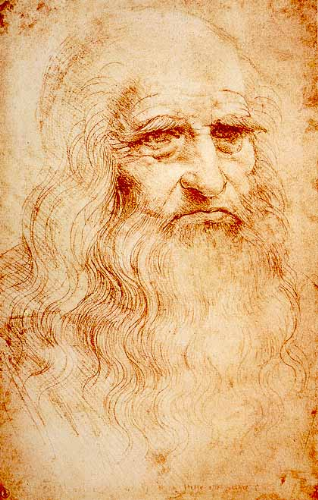
©
Леонардо навчався лише в початковій школі, не знав латини, не полемізував про античну спадщину, відому йому здебільшого з переказів, але здійснив відкриття, які випередили його епоху на сотні років. Ось кілька промовистих прикладів того, як навчання у «вчителя всіх учителів», тобто природи, мало вражаючий ефект:
-
Леонардо фактично сформулював перший і третій закони Ньютона: «Жодна нежива річ не рухається сама по собі, але її рух зумовлений іншими (...) Будь-яке тіло, що перебуває в русі, рухається постійно, доки в ньому зберігається імпульс сили, наданої рушієм».
-
Леонардо зрозумів те, що в 1738 році описав математик Даніель Бернуллі: швидкість потоку повітря над поверхнею крила вища, ніж під крилом.
-
Він зробив начерки й сформулював принципи руху рідини, що витікає з отвору, фактично передбачивши закон Торрічеллі 1643 року.
-
Описуючи хвильову природу руху води й поширюючи ці закономірності на звукові хвилі, Леонардо передчув ефект Доплера (1840 рік).
-
У своїх записниках він висловив здогадку щодо природи світла, яку лише через двісті років математично сформулював П’єр де Ферма.
-
Лорд Релей і Альберт Ейнштейн пояснили явище, чому небо видається синім; проте записи Леонардо майже не відрізняються від їхніх висновків: «Я стверджую, що синява неба, в якій ми бачимо повітря, не є його власним світлом, а народжується від теплої вологи, що випаровується у вигляді найдрібніших і невідчутних атомів. У неї врізається проміння сонця, і вона стає світлішою нижче від тієї темряви безмежної пітьми, яка покриває її зверху у вогненному просторі».
Було б значним перебільшенням сказати, що наукове мислення Леонардо (1452–1519) спиралося на сучасну йому традицію. І тим більш дивним видається припущення, ніби геній Відродження був одержимий відродженням тієї традиції, яку він знав лише опосередковано, — «з чуток».
The Specifics of Leonardo’s Theoretical Anticipations
Leonardo’s Science: The World Through the Eyes of a Great Genius. Fritjof Capra
Leonardo received only an elementary education, did not know Latin, and did not engage in debates about the classical heritage—known to him mostly through retellings—yet he made discoveries that outstripped his era by centuries. Here are several telling examples of how learning from the “teacher of all teachers,” that is, nature, had a profound effect:
Leonardo effectively formulated Newton’s first and third laws: “No inanimate thing moves of itself, but its movement is caused by others (...) Any body that is in motion continues to move as long as the impetus of the force of its mover remains within it.”
Leonardo grasped what mathematician Daniel Bernoulli would describe in 1738: the velocity of airflow above the surface of a wing is greater than that beneath it. He sketched and articulated the principles of liquid flowing from an orifice, thereby in effect anticipating Torricelli’s law of 1643.
By describing the wave-like nature of water movement and extending these observations to sound waves, Leonardo foreshadowed the Doppler effect (1840).
In his notebooks he put forward a conjecture about the nature of light, which only two centuries later Pierre de Fermat would express in mathematical formulas.
Lord Rayleigh and Albert Einstein explained the phenomenon of why the sky appears blue; yet Leonardo’s notes differ little from their conclusions: “I affirm that the blueness of the sky, in which we see the air, is not its own light, but is produced by the warm moisture evaporating in the form of the smallest and imperceptible atoms. Into this strikes the rays of the sun, and it becomes luminous below that darkness of boundless gloom which covers it above in the region of fire.”
It would be a considerable exaggeration to claim that Leonardo’s scientific thought (1452–1519) rested in any serious way on the intellectual traditions of his time. And it seems even more peculiar to suggest that the genius of the Renaissance was preoccupied with reviving a tradition that he knew only indirectly—“by hearsay.”
1535